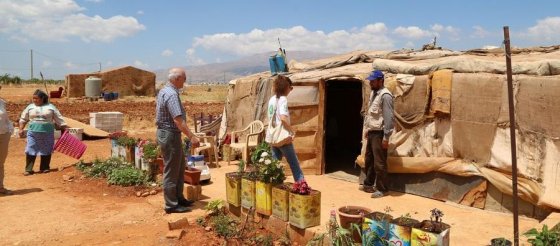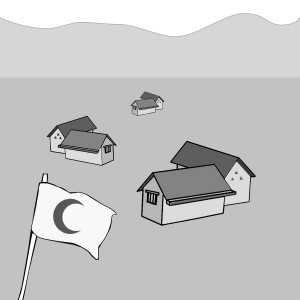المُلخص التنفيذي
في المناطق الريفية، تستقر مجتمعات النازحين في قرى مخصصة لاستضافتهم، أو في مستوطنات غير رسمية ومنتشرة بشكل ذاتيّ خارج المخيمات والمدن (UNHCR 2015b). تختص هذه المناطق، بالاعتماد الشديد على الممارسات الزراعية أو الرعى، ويكون الوصول إلى البنية المجتمعية محدودًا. يصف هذا المقال موقف اللاجئين والنازحين داخليًا (IDPs) في المناطق الريفية
مقدمة
بالنسبة لملايين اللاجئين والنازحين داخليًا (IDPs)، فإن المستوطنات التي يتم إنشائها بشكل ذاتيّ تشكل البديل المفضل عن مخيمات (SCHMIDT 2003). وتشمل مزايا السكان النازحين إمكانية عدم الكشف عن هويتهم فضلا عن إيجاد سبل عيش مستقلة (UNHCR 2015a). على الجانب الآخر، نجد أن الناحين داخليًا واللاجئين الذين يعيشون خارج المخيمات يكونون مدفوعين بشكل خاص للعودة إلى ا لمناطق الأكثر فقرًا والأكثر حرمانًا، كما يعانون عادةً من عدم وجود مستندات قانونية توضح هويتهم وتحميهم من الاستغلال، أو القبض عليهم واحتجازهم (UNHCR 2015b).
ويستقر غالبية السكان النازحين خارج المخيمات في المجتمعات الحضرية ، بينما يستقر بعض النازحين داخليًا واللاجئين أيضَا في مناطق ريفية. وبينما نجد أنه من الصعب تحديد نوعية المناطق فى هذا السياق طبقا لحجم السكان ( الحدود مختلفة عالميا)، إلا أن المجتمعات الريفية يمكن تحديدها بشكل شائع من خلال اعتمادهم الأقوى على الممارسات الزراعية أو الرعي، واتصالهم المنخفض بالبنية المجتمعية (UNHCR 2015c). من بين العدد الإجمالي للسكان اللاجئين المقيمين خارج المدن والقرى، نجد نحو 2% منهم يعيشون خارج المخيمات المخططة أو المدارة بطريقة نظامية (UNHCR 2016).
ما يميز المناطق الريفية عن المخيمات أو المناطق الحضرية، هو أن موارد السكان المحليين يكون قد تم تمديدها بالفعل قبل وصول النازحين، ويكون الوصول إلى الخدمات الاجتماعية الأساسية، والتعليم والرعاية الصحية محدودًا. تعاني المجتمعات الريفية الصغيرة والمتوسطة الحجم من ضعف قدرتها على امتصاص النازحين، حيث تتعرض لتأثير سلبي قوي يؤثر على مصادر العيش وكسب الرزق في المجال الزراعي أو الرعي الضعيف أساسًا وذلك بسبب تعدادهم الكبير، ومستويات الفقر العالية، وخيارات كسب العيش المحدودة لديهم. وفي نفس الوقت، فإن المناطق النائية تتلقى دعمًا منخفضًا من الحكومات أو مجتمع المساعدات. ولهذا السبب، فإن المجتمعات المستضيفة للنازحين تعاني عادةً وبشكل متساوي تقريبًا، وهو ما يسهم في رفع معدلات التوتر والصراعات (THE GLOBAL CCCM CLUSTER 2014 and UNHCR 2015c).
أنواع الملاجئ في المناطق الريفية
القرى المستضيفة
عندما تستقر مجتمعات النازحين في القرى المستضيفة لهم، فإنهم يعيشون عادةً بين عائلات محلية، أو على أراضي، أو ممتلكات مملوكة للسكان المحليين. وهذا أمر شائع بشكل خاص في الحالات التي يتقاسم فيها النازحون والمجتمعات المحلية علاقات ثقافية أو دينية (ولكن ليس على سبيل الحصر) (UNHCR 2015c).
المستوطنات المنشأة ذاتيًا المنتشرة بدون غطاء قانوني
خارج القرى، يستقر النازحين في مجموعات صغيرة على أراضي، أو في بنايات غير مسموح لهم بشغلها بشكل قانوني. وعند الاستقرار في مثل هذه الأماكن المتناثرة والمنتشرة على مساحات واسعة من الأراضي، فإن هؤلاء النازحين يتلقون مساعدات وتوجيهات قليلة أو لا يتلقون مساعدات على الإطلاق من المجتمعات المساعدة، أو من الحكومة المحلية (UNHCR 2015b)..

عائلة لاجئين تقيم خارج موطنهم المؤقت في مستوطنة غير رسمية، قرية البيكا، لبنان. المصدر: OXFAM (n.y.)
الاستجابات الإنسانية في المناطق الريفية
إلى جانب تأمين الوصول الكافي والذي لا يستند إلى أساس عنصري تمييزي إلى تسكين وتسهيل سبل المعيشة الصحية، ومؤون التغذية، والأمان، والراحة، فإن الاستجابات الإنسانية التي تتصف بالمحدودية عادةً في المناطق الريفية تركز على استعادة الموارد المحلية، والحفاظ عليها، وتحسينها في مجتمعات النازحين والمجتمعات المستضيفة لهم. ومن خلال تدعيم الاقتصاد المحلي والقدرات المحلية، فإن الاستجابات الإنسانية تستهدف بناء البيئة الحاضنة التي تسمح للنازحين والمجتمعات المستضيفة بأن تلبي الاحتياجات الأساسية للنازحين واللاجئين، وأن يعيشوا حياة منتجة، ومتناغمة، وكريمة تؤدي إلى تحقيق عوائد إيجابية مستمرة على المدى الطويل (UNHCR 2015b, UNHCR 2015c, UNHCR 2015d). في حين، نجد أن الاستجابات الإنسانية في المناطق الريفية تواجه عقبات قوية تتضمن:
• محدودية الوصول إلى مناطق النزاعات الريفية
• محدودية الجهود والقدرات الانسانية المبذولة للاستجابات المعقدة خارج المخيمات في المواقع الموزعة على مناطق جغرافية مترامية الأطراف
• الفهم المحدود لاستراتيجيات الاستجابات الإنسانية للمناطق الريفية خارج المخيمات
• التمويل المحدود بسبب عدم وضوح الرؤية وقلة اهتمام وسائل الإعلام
In Lebanon, Syrian refugees call for dignity and work
FMO Thematic Guide: Camps Versus Settlements. Forced Migration Online
UDOC Urban Displacement & Outside of Camp. The Global Camp Coordination and Camp Management Cluster
This desk review looks at issues and challenges of supporting populations in urban displacement settings and outside of camp locations. It aims to explore how CCCM resources and experiences of camp-based responses can be applied to addressing the needs of displaced populations outside of camps, in particular in urban environments.
THE GLOBAL CCCM CLUSTER (2014): UDOC Urban Displacement & Outside of Camp. The Global Camp Coordination and Camp Management Cluster. The Global Camp Coordination and Camp Management ClusterGlobal Trends Forced Displacement in 2015
Community Based Hosting Arrangements. In: Emergency Handbook
Alternatives To Camps - Response In Urban And Rural Settings
Settlement In Rural Areas. In: Emergency Handbook
Livelihoods and Self Reliance in Rural Areas. In: Emergency Handbook
الحق في المياه.
يستند هذا المنشور إلى وثيقة الحق في المياه، التي أصدرﺗﻬا منظمة الصحة العالمية، ومفوضية الأمم المتحدة السامية لحقوق الإنسان، ومركز حقوق الإسكان وحالات الإخلاء، ومنظمة الإعانة على توفير المياه، ومركز الحقوق الاقتصادية والاجتماعية في عام ٢٠٠٣. وهو يبدأ بشرح المقصود من الحق في المياه، ويبين ما يعنيه هذا الحق لبعض الأفراد والجماعات على وجه التحديد، ثم يتطرق بالتفصيل إلى التزا مات الدولة فيما يتعلق ﺑﻬذا الحق. ويختتم باستعراض عام لآليات المساءلة والرصد على كل من الصعيد الوطني والإقليمي والدولي.
منظمة الصحة العالمية , ﺑﺮﻧﺎﻣﺞ ﺍﻷﻣﻢ المتحدة ﻟﻠﻤﺴﺘﻮﻃﻨﺎﺕ ﺍﻟﺒﺸﺮﻳﺔ,الأمم المتحدة (2012): الحق في المياه. . الأمم المتحدة، جينيف.سويسرا.: URL [Accessed: 14.08.2017] PDFLanguage: Arabic
تقليل الفجوة الريفية الحضرية -عن طريق التنمية المتكاملة
Language: Arabic
الصرف الصحي الموقعي والمركزي - للمدن والتجمعات السكانية الصغيرة
سياسات التنمية المستدامة للمجتمعات الريفية الفقيرة - مشروع مبادة التوعية بالاهداف الانمائية للالفية
Language: Arabic
IFAD Announces $100 Million initiative to assist refugees, displaced people and their host communities in rural areas
The International Fund for Agricultural Development (IFAD) announcement for the establishment of a new financing facility to assist refugees, displaced people and their host communities to address the increased pressure put on rural areas by the influx of millions of people. The facility will be now launched as a Clinton Global Initiative (CGI) Commitment to Action at the CGI 2016 Annual Meeting which coincides with the United Nations Summit for Refugees and Migrants.
IFAD (2016): IFAD Announces $100 Million initiative to assist refugees, displaced people and their host communities in rural areas. Rome: The International Fund for Agricultural Development URL [Accessed: 19.09.2016]Migrant Integration in Rural Areas – Evidence from New Countries of Immigration
This thematic issue of UNESCO’s International Journal on Multicultural Societies (IJMS) addresses the issue of migration will remain an important part of the “new Europe” by exploring integration approaches and processes for different groups of migrants in new settlement countries at macro and micro levels. It pays particular attention to the geographical dimension of migrant integration by examining both urban and peripheral/rural contexts. This introduction provides the background and context to four subsequent contributions.
UNSECO (2007): Migrant Integration in Rural Areas – Evidence from New Countries of Immigration. Paris: The United Nations Organization for Education, Science and Culture URL [Accessed: 20.09.2016]WASH in Rural Areas
This entry discusses WASH responses in rural dispersed settings. WASH interventions help to improve hygiene and health, and reduce morbidity and mortality among both refugees and host populations. In the first phases of an emergency, a WASH response in rural dispersed settings focuses on identifying WASH infrastructural gaps and needs, and software components required, as well as monitoring the WASH situation.
UNHCR (2015): WASH in Rural Areas. المُدخلات: UNHCR ; (2015): Emergency Handbook. Geneva: . URL [Accessed: 26.10.2016]IDPs in Host Families and Host Communities. Assistance for Hosting Arrangements
This study examines cases where UNHCR and other humanitarian actors have implemented programmes to support hosting, both in individual families and host communities, with a view to sharing experiences and learning for future programmes. Examples of assistance methods examined in this study cover different displacement contexts and phases. Overall, the study shows that it is possible to support hosting situations but that doing so may be more complex and time-consuming than assisting IDPs in camps. It is important to recognize that in some cases, camps may provide greater protection from violence and abuse. The aim should be to respect how IDPs choose to cope with their displacement and to support their choices where possible.
DAVIES, A. (2012): IDPs in Host Families and Host Communities. Assistance for Hosting Arrangements. Geneva: United Nations High Commission for Refugees URL [Accessed: 07.11.2016]Plan of Action: Jordan 2014–2018 Resilient Livelihoods for Agriculture and Food and Nutrition Security in Areas of Jordan Affected by the Syria Crisis
The overall goal of this Sub-Regional Strategy is to strengthen the resilience of livelihood systems (including individuals, households, communities and agro-ecosystems). In this context, the strategy identifies key emergency response, agricultural restoration, livelihood recovery, risk-sensitive agricultural development and related policy and capacity development interventions aimed at humanitarian relief for internally displaced persons (IDPs), refugees and returnees; recovery and stabilization of national agriculture sectors; and strengthening of the resilience of Egyptian, Iraqi, Jordanian, Lebanese and Turkish host communities to help them withstand the impact of the Syria crisis.
FAO (2014): Plan of Action: Jordan 2014–2018 Resilient Livelihoods for Agriculture and Food and Nutrition Security in Areas of Jordan Affected by the Syria Crisis. Rome: Food and Agriculture Organisation of the United Nations Regional Office for the Near East and North Africa Amman URL [Accessed: 19.09.2016]The Impacts of Refugees on Neighbouring Countries: A Development Challenge. World Development Report 2011
This report shows the distribution of refugees in asylum countries using a series of graphs and tables which highlight the fact that the largest percentage of refugees are found in countries neighbouring their country of origin, most of which are middle-income countries. However, in some of these middle- income host countries, refugees are located in low-income and fragile border regions. The second section discusses how neighbouring countries that host refugees for protracted periods experience long-term economic, social, political, and environmental impacts. The study has two main sections. The first section describes trends in distribution of refugees in asylum countries whereas the second section discusses how neighbouring countries that host refugees for protracted periods experience economic, social, political, and environmental impacts. The brief lastly discusses examples of global experience of development interventions that have focused on mitigating the negative impacts of large-scale and protracted displacement.
PUERTO COMEZ, M. CHRISTENSEN, A. YEHDEGO ARAYA, Y.. (2011): The Impacts of Refugees on Neighbouring Countries: A Development Challenge. World Development Report 2011. Washington, D.C.: The World Bank URL [Accessed: 20.09.2016]www.unhcr.org
This is the official web site of the UNHCR, the UN Refugee Agency, containing key and up-to date information about the status of refugees worldwide, as well as multiple publications and resources.
https://emergency.unhcr.org
The UNHCR Emergency Handbook is the 4th edition of UNHCR’s Handbook for Emergencies, first published in 1982. This digital edition is primarily a tool for UNHCR emergency operations and its workforce. It contains entries structured along seven main topic areas: Getting ready, Protecting and empowering, Delivering the response, Leading and coordinating, Staff well-being, Security and Media.
www.globalcccmcluster.org
THE GLOBAL CCCM CLUSTER (2014): UDOC Urban Displacement & Outside of Camp (UDOC).This desk review looks at issues and challenges of supporting populations in urban displacement settings and outside of camp locations. It aims to explore how CCCM resources and experiences of camp-based responses can be applied to addressing the needs of displaced populations outside of camps, in particular in urban environments.
www.unocha.org
United Nations Office for the Coordination of Humanitarian Affairs (OCHA) is the part of the United Nations Secretariat responsible for bringing together humanitarian actors to ensure a coherent response to emergencies. OCHA also ensures there is a framework within which each actor can contribute to the overall response effor

